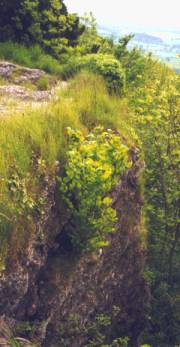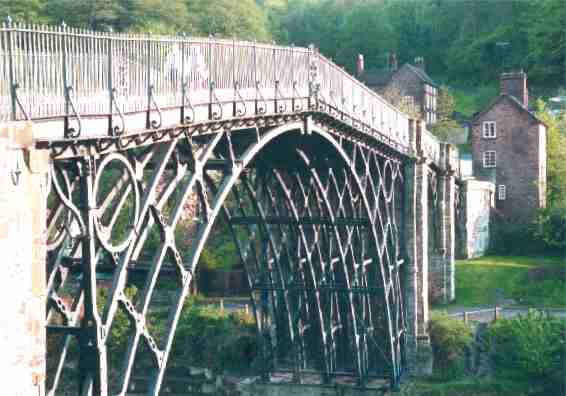Geology / Wenlock Edge
The most famous Silurian site in the world is Wenlock Edge ➚ in Shropshire, England. Here an ancient coral reef (400 million years old) is now exposed as a long ridge of woodland set amongst the Shropshire hills. Because the Silurian saw a general rise in sea level after the Ordovician glaciation many land areas were inundated by shallow seas. Coral reefs flourished in areas of shallow water that were free of heavy deposition of mud. In Northern America ➚ coral reefs were also widespread.
The name 'Wenlock' is believed to be a corruption of the Welsh name for 'White Church' for the town because of its white church, as it was made from local Silurian limestone. It can be argued that although the rocks are named after the town, the town itself was named after the rock.
The following picture shows the long escarpment of Silurian Much Wenlock Limestone forming a ridge from the Wrekin south west to Craven Arms.

The poet A.E. Housman ➚ (1859-1936) set his famous poem 'On Wenlock Edge' (a part of 'A Shropshire Lad') at this location.
 |
On Wenlock Edge the wood's in trouble; His forest fleece the Wrekin heaves; The gale, it plies the saplings double, And thick on Severn snow the leaves. 'Twould blow like this through holt and hanger When Uricon the city stood: 'Tis the old wind in the old anger, But then it threshed another wood. Then 'twas before my time, the Roman At yonder heaving hill would stare: The blood that warms an English yeoman The thoughts that hurt him, they were there. There like the wind through woods in riot, Through him the gale of life blew high; The tree of man was never quiet Then 'twas the Roman, now 'tis I. The gale, it plies the saplings double, It blows so hard, 'twill soon be gone: To-day the Roman and his trouble Are ashes under Uricon |
Ralph Vaughan Williams ➚ set this poem to music in his song cycle On Wenlock Edge ➚
The picture to the left shows the view from the top of the Edge looking South West, the Silurian Wenlock limestone 'cliff' is clearly visible.
Ironbridge and the Industrial Revolution
Shropshire's geology is significant as it was a factor in the start of the Industrial Revolution. Coalbrookdale, just to the north of Much Wenlock, was the first place in the world to mass produce quality iron and steel.
In the Ironbridge Gorge, the River Severn has cut a deep valley cutting through mainly Carboniferous rocks. Early ironworkings could extract coal, iron and Silurian limestone just by following the gently sloping beds into the sides of the gorge. The limestone is vital in quality iron-making, acting as a flux in the iron-making processes removing impurities from the iron ore to produce 'slag'. The River Severn provided excellent transportation in the days before steam railway engines and tarmac roads.
It is here at the World Heritage site of Ironbridge ➚ in 1777 that the world's first iron bridge was made to cross the river Severn. The cost of the construction nearly bankrupted the pioneering ironsmith Abraham Darby. The original, magnificent bridge still stands today :

Footnotes
Uriconium
The Roman name for the large roman city of Wroxeter ➚ that stood on the river Severn at the western foot of the Wrekin. During the final stages of Roman control of Britain (circa 400AD), Uriconium was believed to be the most important city in Britain (the other main centers had been overrun by the Anglo-Saxons). The attraction of Britain to the Romans was rich agricultural land, farmed continuously from the Bronze Age. According to Graham Phillip's book The Quest for the Holy Grail ➚ it was here that King Arthur ruled and it may be that Uriconium was the actual basis for the legend of Camelot with its white walls of roman stone.
The Wrekin
The Wrekin ➚ is a large hill (1,334 ft) that dominates much of Northern and Eastern Shropshire. Consisting of PreCambrian metamorphic and igneous rocks it is as truly ancient as it looks. It forms the northern-most exposed part of the ancient Church Stretton fault system. This fault line was as significant as the San Andreas during its many periods of activity. The main movement along this fault has been vertical rather than horizontal, the PreCambrian landmark of the Long Mynd demonstrates the large vertical displacement along the fault (over 3000 metres in places). It is a deep crustal suture likely to become active in the distant future when Britain is subject to tectonic forces as the Atlantic Ocean closes in the next 200 million years.
The local saying 'all the way around the Wrekin' is an expression of long-windedness.

The Severn
The River Severn is Britain's largest river, running from its source in mid Wales it collects water from much of the Welsh Borderlands and West Midlands before flowing into the Bristol Channel. One of only a handful of rivers that experience a tidal bore ➚ at Spring tides.
